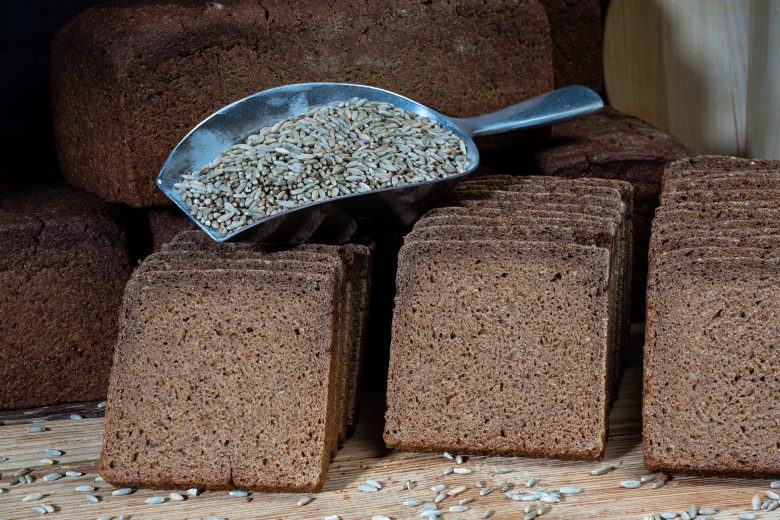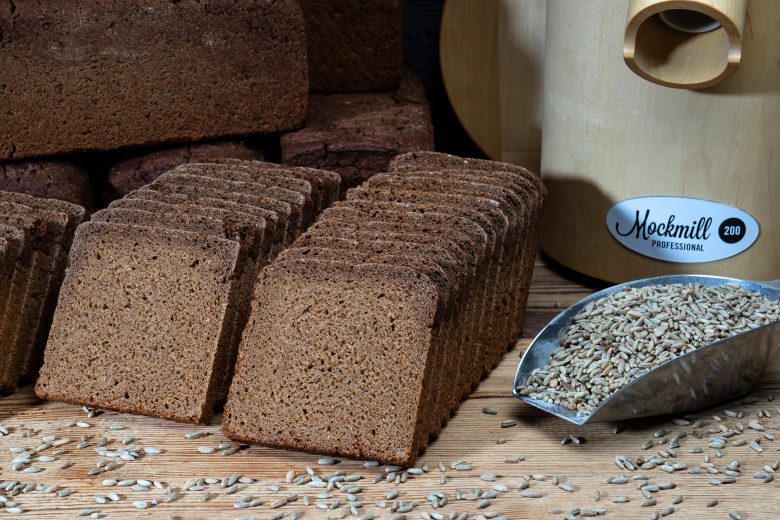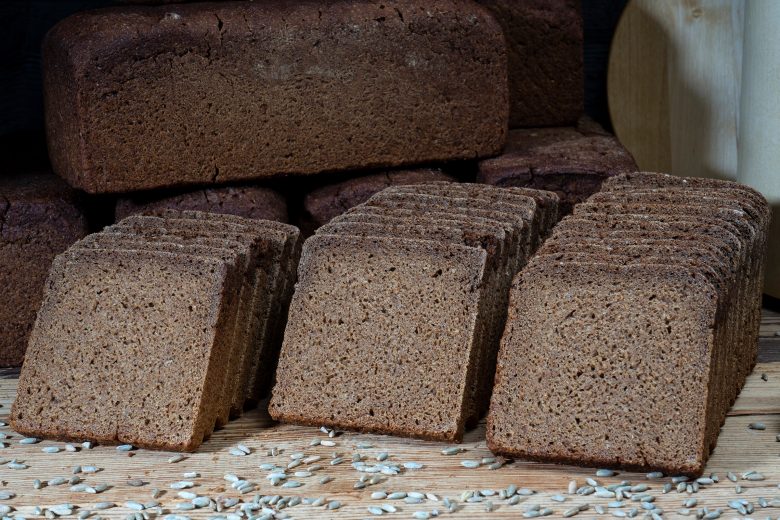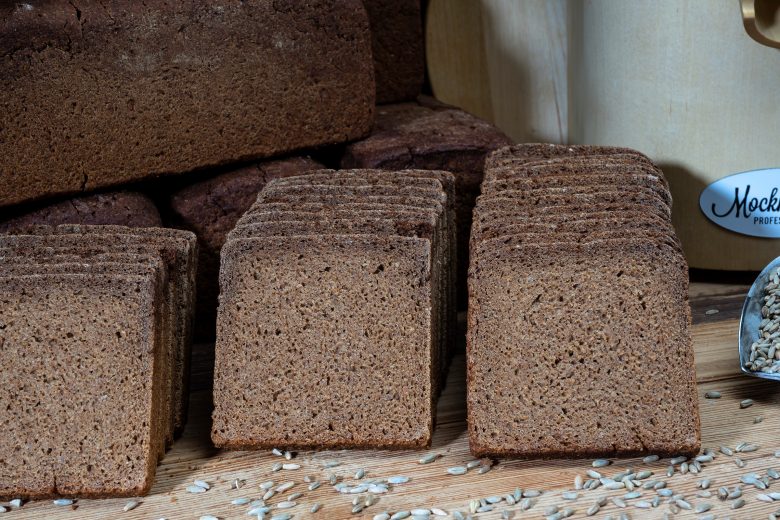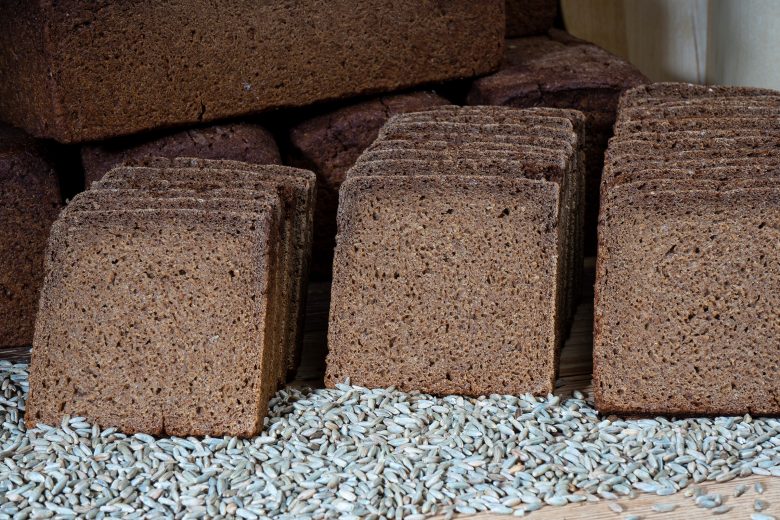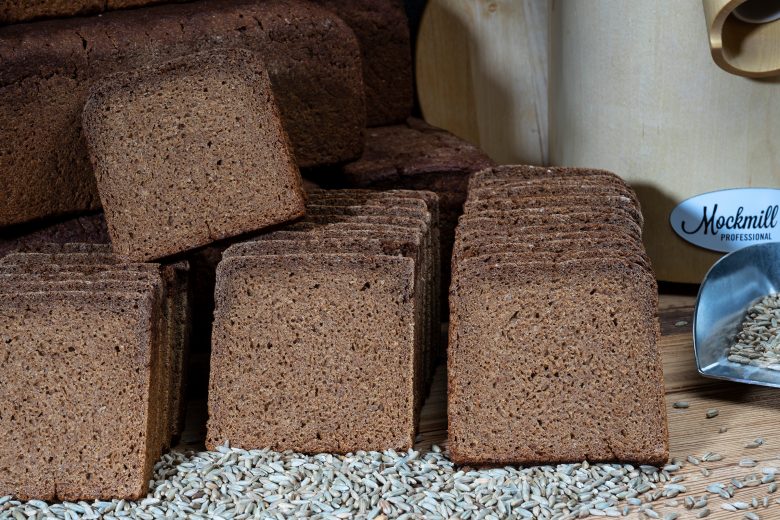Masterclass Pumpernickel
Rye Masterclass
Schelli: You criticized my grammar!
Me: Never! As long as you don’t mess with my dough, I won’t mess with your grammar.
This exchange should help you understand the commitment we (Didi vs. Schelli) each bring to our line of work.
Rise and acidification of traditional German breads.
Recipes:
- Game without borders: Baltic Cooked Dough Bread
- Ultimate Pumpernickel
Classification
German breads that emphasize rye have a bad reputation in Mediterranean countries- known as heavy, dense and sour. An inedible baked brick.
Germans perceive it quite differently in their own country. The first thing a German misses when he spends more than a week away from home is his beloved rye bread. In this case, it has nothing to do with poor taste. Rather, the rye is elevated through expert fermentation bringing about a sense of home and satisfaction- German Soulfood.
However, in the vast majority of German bakeries rye sourdough is used only as a seasoning to give the bread acidity and flavor. Baker’s yeast is used as a raising agent. To save time and provide production reliability yeast is not spared. Contrary to the fluctuating quality of older rye harvests, more recent harvests don’t require souring to produce a visually appealing bread. Lower flour falling numbers in the old days had to be countered with an appropriate pH-value in order to slow down the bread development and to reduce the possibility of proofing errors. Nowadays, hybridized grain is grown almost exclusively- more profitable and reliable. It is disease resistant and higher in protein. Baking technically good bread is hardly a challenge these days.
However, consumer expectations of bread are changing from a belly-filler to a luxury food. The drivers of this change are hobby bakers and the progressive, cutting-edge chefs of Michelin gastronomy in Germany rather than the classical French cuisine. With this there is a focus on fermentation of which bread is an understandable part.
Bread as a luxury product cannot be mass produced. For us, an excellent product stands on three columns:

- Craftsmanship
- High quality flour
- Natural fermentation, modern sourdough knowledge
From the baker’s point of view it is decisively understood that craftsmanship is required to bake great bread. We believe that recognizing flour quality, proper dough ripening, and being able to handle dough are basic requirements. Consumers are increasingly expecting taste and aesthetics while the professionals are more focused on streamlining production and are reluctant to meet the consumer demands.
We arrive at the second point, flour quality; it is not about pest infestation or protein content. In recent decades when selecting grains, flavor was a secondary factor. The ease of baking was important and protein content was the currency for farmers, millers, and bakers. At the forefront was the machinability of the dough in order to be produced cheaply in mass quantity.
The decreasing consumption of rye flour in Germany correlates closely with the increasing falling number in rye grain in the past decades. A causal relationship isn’t proven but the obvious result is increasingly dry bread. This should be clarified: The falling number is an indicator of enzyme activity, the lower the falling number the higher the activity.
Dough with low enzyme activity (high falling number/correspondent to the current rye qualities) are less demanding to process but also of a bland taste and “dry baked” i.e., the opposite of tender.
The solution is provided by flavor enhancers. German bakers handle it by adding malt. The rest is handled by the bakery supply industry. They correct for the undesired properties of the current harvest and even out the taste profile. This way the customer in northern Germany receives the same bread as the customer in southern Germany even under the same label.
The following measures can help avoid a dry bake:
- Choose an ancient rye grain varietal: Champagne rye flour or Waldstaunden rye flour have significantly lower falling numbers and richer taste compared to many hybrid varieties.
- Reduce the falling number through the addition of a suitable proportion of enzyme active flour (the highest level of craftsmanship, which is achieved by few bakers: the enzyme effect on the dough does not follow a direct linear relationship!)
- Addition of a rye malt scald
- Increase the whole grain percentage
- Work with soaked, scalded, and cooked flour additions
- Add leftover bread (Use of leftover bread- on this point the authors are divided: one loves it, the other feels it covers up the delicate, and succulent flavor of the fermentation)
Fermentation
Fermentation/fermenting has ancient roots in all cultures and many areas of food preparation and preservation. Today, the know-how is mostly optimized over exchange on the internet and food tourism. Rye bread preparation with fermentation/dough souring with help from yeast and bacteria carries a deep tradition in Germany. The knowledge came about empirically and led to very different preparations in different places in Germany; however, the preparations are used by very few professional bakers. Even in the technical schools the knowledge is not taught- and unfortunately not conserved. Today, because of the invention of baker’s yeast, rye dough handling has been greatly simplified with leavening and acidification separated into two independent processes. The desired dough characteristic “rise” is achieved with the help of yeast, the critical characteristic of “acidity” with help from mature, stable rye sourdough. Fine tuning flavor adjustments through fermentation control or different types of grain are often just left out.
In the following we lay out a brief characterization of the most important concepts for traditional, baker’s-yeast-free rye and mixed rye breads. All of the traditional German sourdough methods are made with rye flour.
Berlin Quick Sour:
Fast, warm, soft method, a lot of starter is used, for mild mixed flour bread, an exotic one in German bakeries.
Key figures: Starter content 20% of the rye levain total. Rise time (RT): 4h, Dough temperature (DT) 35°C, Dough yield (DY): 200
Monheim Salt Sour:
The idea of this method is to make a levain only twice a week. The addition of salt reduces the metabolic rate (stabilization) of the levain, an important side effect is that acetic acid producers are slowed down. Simple, safe in result, balanced in taste.
Key figures: Starter content 20% of the rye levain total. RT: 15h, DT 32°C falling to 22°C, DY: 200, 2% salt (reduce accordingly when preparing main dough) acidification 30-40%
Detmolder 3-Stage Sour (Classic!)
This method is considered the apex, it provides mild, aromatic, and powerful sourdough. If you time the last stage to be short, the workability decreases and the bread quality increases.
Key figures:
1st stage (Refresh sour): 1:2:3 (Starter:Flour:Water), RT: 5-8h, DT 25°C-26°C, DY 200-210,
2nd Stage (Foundation sour): 2:5:3 (Starter:Flour:Water), RT: 6-10h, DT 23°C-28°C, DY: 150-165,
3rd Stage (Full sour): 2:3:3 (Starter:Flour:Water), RT: 3-10h, DT 25°C-32°C, DY: 180-200, acidification 30-40%
Detmolder 2-Stage Sour
Proven practice for high quality starter cultures. Special consideration: 1st stage can be left long. Good, safe all-rounder for rye sourdough baking.
Key figures:
1st Stage: 1:12:6 (Starter:Flour:Water), DT: 25°C, RT: 15-24h, DY approx. 150
2nd Stage: 1:2:2 (Starter:Flour:Water), DT: 28°C, RT: 4h, DY approx. 190
Detmolder 1-Stage Sour
The method with the highest acidification capacity and the greatest workability. i.e.: pH and sourness of these breads are most pronounced. That is why it is best suited for acid tolerant flours/milled grains. Only common in German bakeries in combination with baker’s yeast. Doctrine states that the leaven power of the one stage method is not sufficient to give bread the desired rise. The authors of this article are of the opinion that the quality of the starter is crucial for the success or failure of such methods without baker’s yeast.
Stage: 1:10:10 (Starter:Flour:Water), DT: 25°C, RT: 15-24h, DY approx. 200
Foam- or Whipped Sour Method
Complex 5-stage method to allow the yeast cultures more oxygen. This is the only way that an adequate number of yeast can reproduce. The point that oxygen is essential for yeast reproduction is often overlooked but is the critical component of this method. It is the most effective way to suppress acid buildup through strengthening the yeast and Co2 production. The rise achieved in the bread is also optimized this way. It is not known to the authors whether this method is used commercially without automation.
Key Figures:
1st Stage: 1:1:2 (Starter:Flour:Water), DT: 23°C, RT: 3h, DY approx. 300
2nd Stage: 1:1:2 (Starter:Flour:Water), DT: 23°C, RT: 3h, DY approx. 300
3rd Stage: 1:1:2 (Starter:Flour:Water), DT: 23°C, RT: 3h, DY approx. 300
4th Stage: 1:2:2 (Starter:Flour:Water), DT: 23°C, RT: 6h DY approx. 265
5th Stage: 3:1:1 (Starter:Flour:Water), DT: 23°C, RT: 20 min, DY approx. 170
Summary
With the help of the traditional methods of sourdough preparation described, we are able to adapt our rye bread recipes very precisely to our goals. Depending on the degree of automation of the bakery, the techniques discussed can be more or less adopted.
This article can serve as a tool chest or an expansion of your own recipe development possibilities.
This knowledge helps us to control techniques, tools for pre-dough preparation, to produce high-quality, artisanal bread and to understand the processes behind it. To be able to correct and adjust for too much or too little acid.
Mixed rye breads based on these techniques have a quality that is rarely known outside of Germany – nuanced, earthy-aromatic breads that are produced through fermentation are increasingly finding their way into sophisticated cuisine. Michelin starred chefs agree that these breads have earned their place at the table.
As a suggestion to experiment we have compiled the following example for you:
Lithuanian Scald Bread
Rationale: In order to cast out the above discussed weakness from standard rye flour, we reach deep into the bag of tricks and enlighten the German rye bread scene with a scarcely known Baltic specialty.
My Lithuanian neighbors had tears of joy in their eyes when they sampled this bread.
The various regional bread specialties of Lithuania, Estonia, Latvia, Belarus, and Russia were likely known in East German garrison towns and would have been adopted here and there. The flavor of these breads are legendary and unmatched.
Traditionally the production of rye and the properties of the produced breads differs from the ideas of Austrian/German breads. The incorporation of a particular preliminary stage seems universal and is therefore the focus of our method. A so-called “cooked dough” is used in the assembly of rye and mixed-flour rye breads. Part of the rye flour is stirred into hot water: a viscous cooked dough is formed.
This cooked dough is left to saccharification/malting by enzyme active malt flour and later added to the fermenting sourdough. Only after the combined fermentation of the saccharified cooked dough with the sourdough is the preliminary stage ready to be used. Sometimes you will see a preparation that separates the cooked dough with malted flour from the sourdough.
An additional step is also possible: in addition to the preliminary stage of cooked dough and sourdough, a liquid sourdough can be added to achieve the desired level of sour. The extensive preparation of the preliminary steps primarily serves to improve freshness and to attain a malty-tangy taste in the bread. Depending on the raw ingredients, the standing times, and the temperature profile of each stage there are stark differences in the level of breakdown in the so-called cooked dough. The crumb color and structure is greatly influenced by the cooked dough. In addition to the soured cooked dough, various types and amounts of sugar, sugar syrup, honey, fruit jelly, or malt extract are added to the bread dough. The different types of sweetener ensure a mildly sweet, sometimes fruity taste of the rye and mixed rye breads, and lend a positive impact to the shelf life.
Now the toy box is open- here is the production process for a so-called cooked dough bread from Belorussia.
The “all-in” method is used in the case of cooked dough bread by combining the following ingredients in a mixing bowl: Rye flour (approx. Type 1370), malted flour, potato flakes and hot water (around 80°C). For an intensive saccharification the temperature should be held constant at 65°C. In this step the enzymes breakdown the starch into dextrin, malt sugar, and glucose. Except for the potato flakes this is the well-known rye malt scald.
Cooling
After the saccharification step the dough is cooled to approx. 30°C. Important: Even out the temperature through mixing!
Sour
The cooked dough is mixed 1:1 with sourdough with DY 220 and left to ferment for 3-4 hours at a constant 30°C. The final dough should be prepared quickly due to the high fermentation rate, the workability tolerance is low.
Dough Preparation
20% fermented cooked dough
80 % Rye flour
If desired and based on the bread type additional sourdough can be added
2 % Salt
Depending on the type of bread:
Honey, sugar syrup, sugar, or fruit jelly is used
No additional water addition to the dough
Knead slowly for 6 minutes
Dough rest time about 120 minutes
Large loaves are usually baked- a specialty is to bake loaves on large maple leaves. Breads with cooked dough are characterized by their intense flavor and the long-lasting tender crumb.
Incidentally, these breads are baked much darker than in our neck of the woods. On the one hand the toasty flavors fulfill the consumer preferences, on the other hand the bread darkens more quickly in the oven because of the higher sugar content.
Using the example of my neighbors we see that in other cultures bread is highly esteemed and tied to emotions. For us, the first step to mastery is learning traditional skills.
Universal Recipe for Cooked Dough
Recommendation: 10% of total flour
Cooked Dough (DY400) All-in:
100g Rye flour (approx. Type 1370),
2g active malt (2%)
40g potato flakes (4%)
300g water approx. 80°C, stir together.
Temperature should remain constant at 65°C for 6 hours.
Optional whole caraway (not in Pumpernickel!)
Cool to 28°C
30% Rye sourdough preparation (200g starter:200g water: 200g rye flour), 28°C for 3 hours.
After 3 hours add the finished cooked dough (Booster!)
After 2 hours into the main dough
Enough fooling around, now we come to the:
Masterclass Recipe
Pumpernickel as a Pure Westphalian Recipe
We dare to tread into simple elegance- For us it is an art to reduce a recipe to such an extent that it would be worse if a single ingredient or processing step were changed. But with an embellishment it doesn’t get any better.
The original Westphalian Pumpernickel is a frugal bread from a poor region that incorporates the entire grain and plays with the components. The dough is prepared through stages of soaking- with help from grain properties and fermentation- to then be finished in an eternally long baking process. Through which the peculiar mild and infinitely flavorful bread is defined.
This is the opposite of a discount bread. Both in the complexity of the flavor and the production. We break with the tradition by not fully embracing the heat from a cooling oven.
Pumpernickel Masterpiece Recipe/chef-d’œuvre
For a dough weight of 2087g
Total Recipe
| 500g | Coarse Waldstauden rye (Mill setting 15) | 50% |
| 500g | Fine Waldstauden rye (Mill Setting 2) | 50% |
| 950g | Water | 95% |
| 12g | Salt | 1,2% |
| 100g | Dried breadcrumbs | 10% |
| 5g | Yeast | 0,5% |
Sourdough
| 100g | Coarse milled Waldstauden grain |
| 100g | Water |
| 20g | Starter |
Fully dissolve the starter in the water and then mix in the coarse rye. Ensuing ripening time of 12 hours at 25-27°C.
Scald
| 400g | Coarse milled Waldstauden grain |
| 400g | Water 100°C |
| 12g | Salt |
Combine coarse rye and salt in a kneading machine and then add water and mix slowly for 20 minutes. Ensuing standing time of 4-5 hours.
Bread Soaker
| 100g | Dried and finely ground breadcrumbs |
| 200g | Wasser approx. 30°C |
Mix together and let soak for 4-5 hours.
Main Dough
| 500g | Fine milled Waldstauden grain |
| 150g | Water 30°C |
| 220g | Mature grain sourdough |
| 812g | Scald |
| 300g | Bread Flavoring |
Mix together the sourdough, scald, bread flavoring, water and wholegrain flour for 20 minutes on slow. CAUTION: Don’t add any additional water in this mixing phase! Through the squishing of the dough a stronger binding is achieved.
Then let is rest for 30 Minutes.
| 100g | Water |
| 5g | Yeast |
In the second phase of mixing, the yeast is dissolved in water and is added then mixed slowly for a further 20 minutes.
The dough could probably use more water but it is not advisable to use too much (so-called “bacon strips” can occur in the crumb due to the low baking temperature!).
Production
- Let the dough rise for 30 minutes after mixing.
- Then work the dough with a small amount of flour (Dough weight of 1400g/ 25×10,5×10,5cm). Since the Pumpernickel is baked at a low temperature for a long time it must be prevented from drying out. In professional kitchens the loaves are baked in so-called steam-baking trays. (http://www.krause-backformen.de/6-Backformen-Backk%E4sten/18-Isolierter-Backkasten/21,Isolierter-Backkasten-m.-Eins%E4tzen.html). For the hobby baker using a household oven I recommend placing the loaf pan in a roasting bag (z.B.: https://www.moderne-hausfrau.at/p/bratbeutel-p1643588/?variantId=P1643588_231779874)
- Proof for about 45-60 minutes
- The Pumpernickel is baked at a starting temperature of 150°C falling to 100°C.
- Total bake time: 14-16 hours
Bread Brothers Verdict
Admittedly- the unsupervised student has trouble following the exact instructions of the professional while putting aside one’s own creativity.
This often results in comments like: I used quinoa instead of rye meal and replaced the sourdough with baking powder but everyone enjoyed it.
This brings about the second challenge for anyone who bakes with coarse milled grain:
Ensuring cohesion. Do the slices crumble apart? Can they hold up to spreads? Grist from the Müller mill seems to work while bread made with grist from the Meier mill crumbles. Why is that?
The binding – particularly with rye grain breads – is created through a mix of varying particle sizes. Thus, the very finest particles (flour), then fine, medium, and course milled grains should be in a healthy relationship to each other within the dough. If the miller sieves out the finest particles to end up with a more visually appealing and homogenous milled grain product, he can sell it for more. This is counterproductive and you at least have to address the issue.
The intensive kneading of very stiff dough helps. Hold back water from the mix. This is the secret. When proper binding is established, the residual water is added drop by drop to create a homogenous dough.
We ground the grain fresh and selected ancient grain varieties (Champagne, Waldstaude rye). This brought about a special enchantment – the resulting fragrance during the milling process brought to the authors feelings of lust and reproduction – for whatever reason. The freshly ground flour brings a mysterious flavor to the bread – a new paradigm for us. However, it must be said that the combination of freshly ground flour and high quality flours from conventional milling are the best- and above all allow for the most reliable baking results.
The soulfood quality of Pumpernickel is attributable to the feeling of satisfaction.
First Place!
Clear class winner in point value from the combination of complex flavor, satiety time, digestibility.
We come to the individual points:
- Usability- Easy to spread on. Harmony with fresh butter & jam, with enough backbone to combine with ripe cheese, flavorful ham – don’t use the cheap stuff! It would be shameful to do so. Or pickled herring with onion for the fish lovers. Also roast beef combined with marinated radishes to discern the wasabi spiciness!
- Smell: You can detect malty, wild honey flavors (attributable to the starter), buttered toast aromas.
- Mouthfeel: succulent, luscious, with a noticeable bite,
- Taste: Despite a lower salt amount, harmonious, due to the long baking time a slightly malty & sweet note, hints of umami,
- Crust color: For cognac drinkers: cognac colored, for whisky drinkers…well, whisky colored
- Texture: compact, dense, and tender crumb (Recommended first slice after 2 days)
Authors:
Dietmar Kappl and Manfred Schellin travel internationally to give masterclasses and discussions to bring together the practice and theory behind good bread baking.
Dietmar Kappl is a bakery director in Linz (reichlbrot.at), winner of many international bread competitions and he blogs at homebaking.at
Manfred Schellin is a biochemist (University of Bielefeld), sourdough and flour connoisseur. He operates the website bongu.de


